Michelangelo's Madonna and other masterpieces at Our Lady's Church in Bruges
The city of Bruges is a must-see for all art enthusiasts on a trip to Belgium. The capital of West Flanders is a resplendent jewel, with its medieval old town that has been a UNESCO World Heritage Site since 2000, embellished with sumptuous palaces, monuments and churches, as well as important museums with extraordinary paintings from the history of art, with works by Bosch, Van Eyck, Hans Memling just to name a few. Among the most notable sights is the Onze-Lieve-Vrouwekerk or Church of Our Lady, which with its bell tower towers over the city skyline (moreover, it is the second tallest brick tower in the world, with its spire soaring over 115 meters). But it is not only its outstanding architecture that makes it one of the most visited attractions: it is mainly thanks to the masterpieces preserved inside, of which undoubtedly a leading role is played by the work known as the Bruges Madonna, a sculpture by Michelangelo, the first of the few sculptures to have left Italy when the Tuscan master was still alive.
The Gothic church is among the oldest sacred places in Bruges: built in the Carolingian age, it was then remodeled numerous times over the centuries (the nave is dated to 1210, while the beautiful polygonal choir banded with rampant arches was built between 1270 and 1335). A number of significant works are preserved in the church, access to which is free, including a sumptuous 18th-century wooden pulpit in the Baroque style, but the real treasures are kept in theinterior of the relatively recently established museum, which is spread over part of the transepts, the ambulatory and the presbytery, creating a complex that is certainly not extensive but which justifies a ticket price that would be far too exorbitant for a single work, no matter how much it is one of the most important masterpieces in the history of art.
Of great quality are the confessionals carved in oak wood by the hands of Jacob Berger and Ludo Hagheman, scanned by the insertion of figures in the round symbolizing Vice, Faith and some saints. It is one of the most important sculptural complexes in the Flemish city. Among the first chapels one encounters upon entering the museum is the one commissioned by Louis de Gruuthuse, an influential adviser to the dukes of Burgundy and a knight of the Order of the Golden Fleece. The sumptuous palace where he lived and that still bears his name was connected by his initiative to the church through a two-story chapel, from the top of which he and his family could observe religious services, while descending to the lower level he could be joined by a priest to receive communion. The other chapels have mostly been remodeled in recent times: noteworthy are the Chapel of the Sacrament, commissioned by Bishop J.B. Malou in the mid-19th century in the neo-Gothic style and embellished with fine stained glass windows, and the Lanchals Chapel. The latter belonged to Pieter Lanchals, an adviser and close friend of Archduke Maximilian of Habsburg, who in 1488, following a revolt by some Flemish towns, was beheaded during an execution that the archduke was forced to attend. Legend has it that out of revenge, because a swan stood out in the noble symbol of Lanchals, the archduke decreed that a few specimens of those elegant feathers would live forever in the city of Bruges, which are still present today in the so-called “lake of love.”
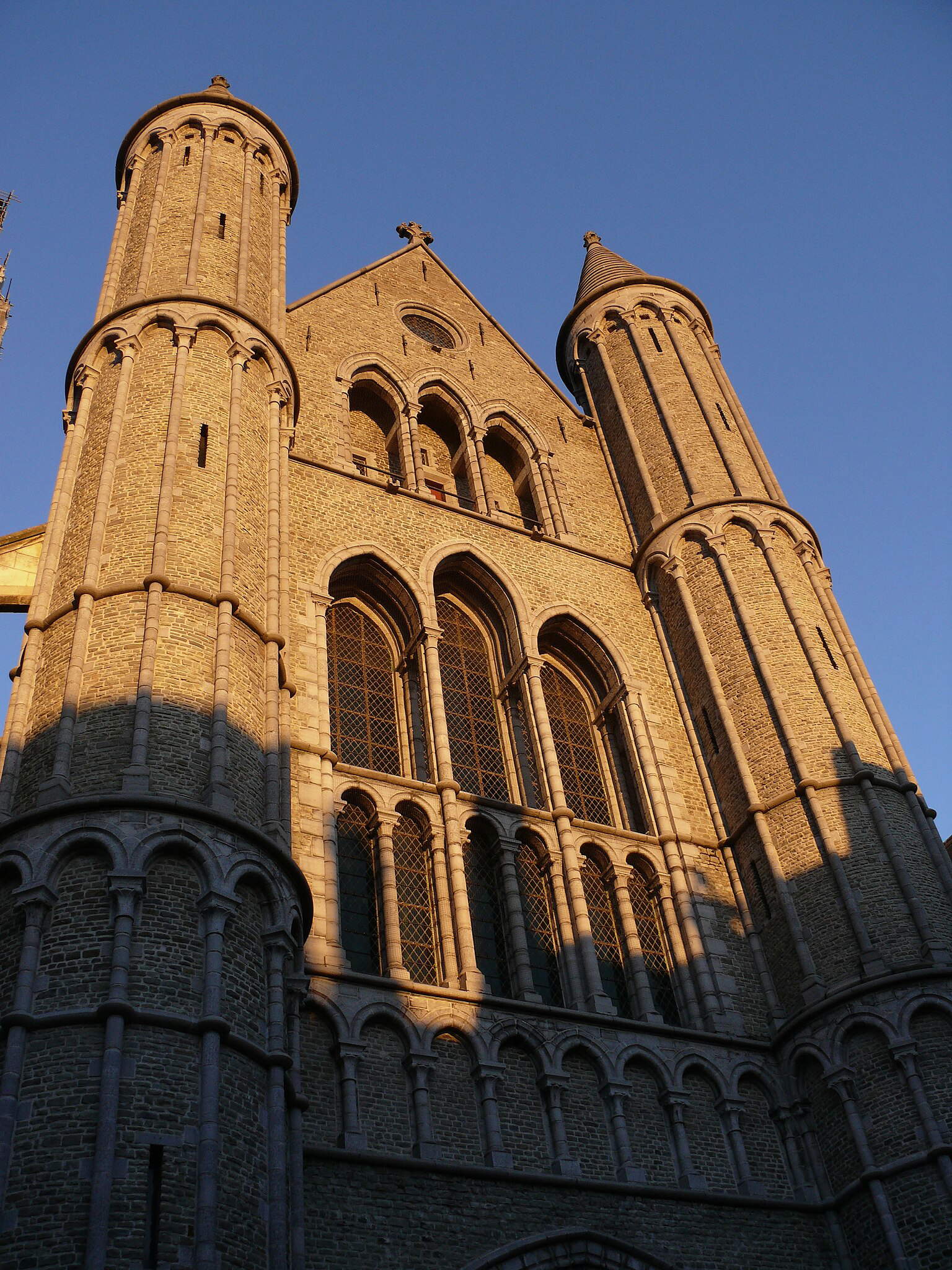
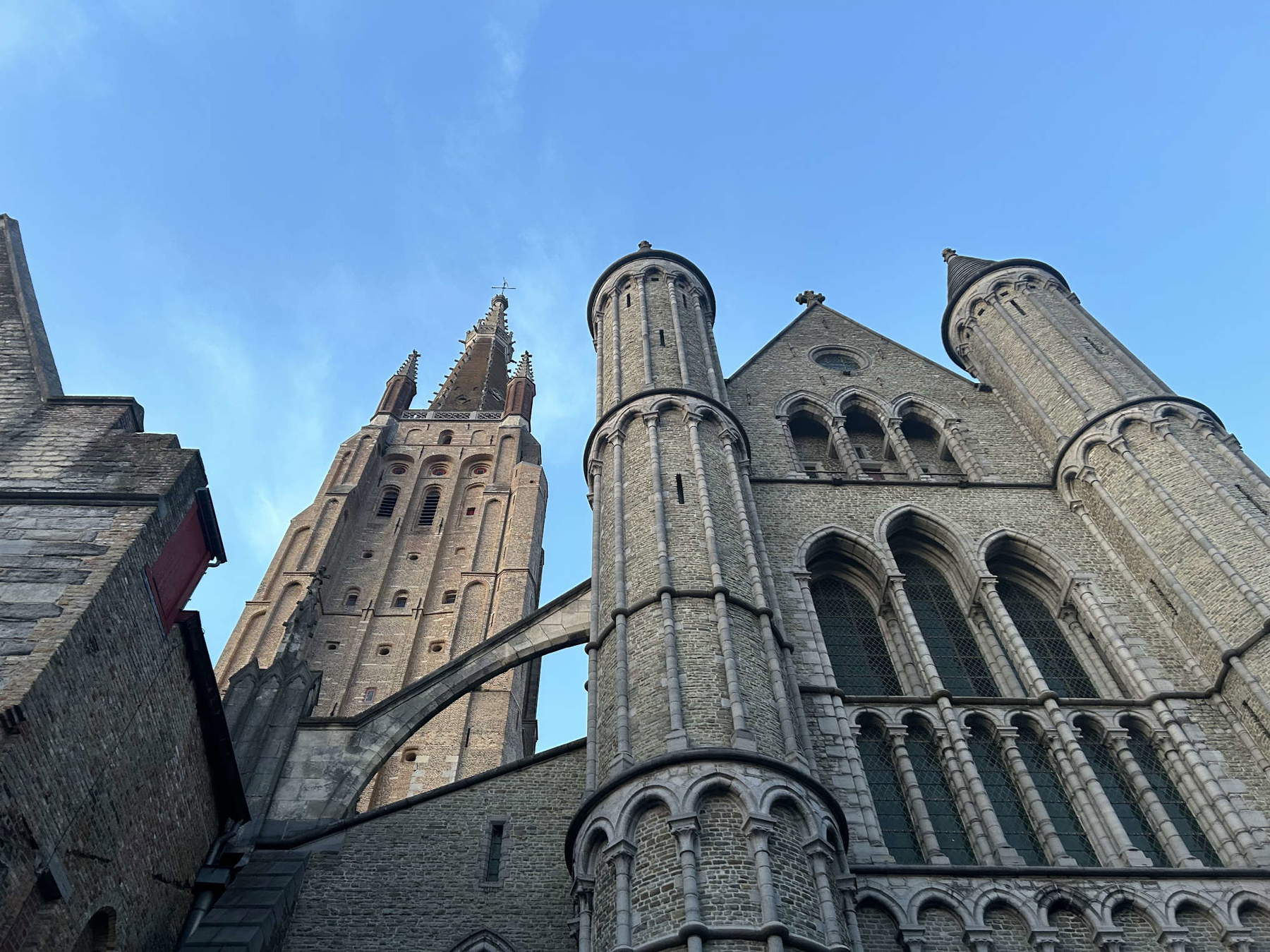
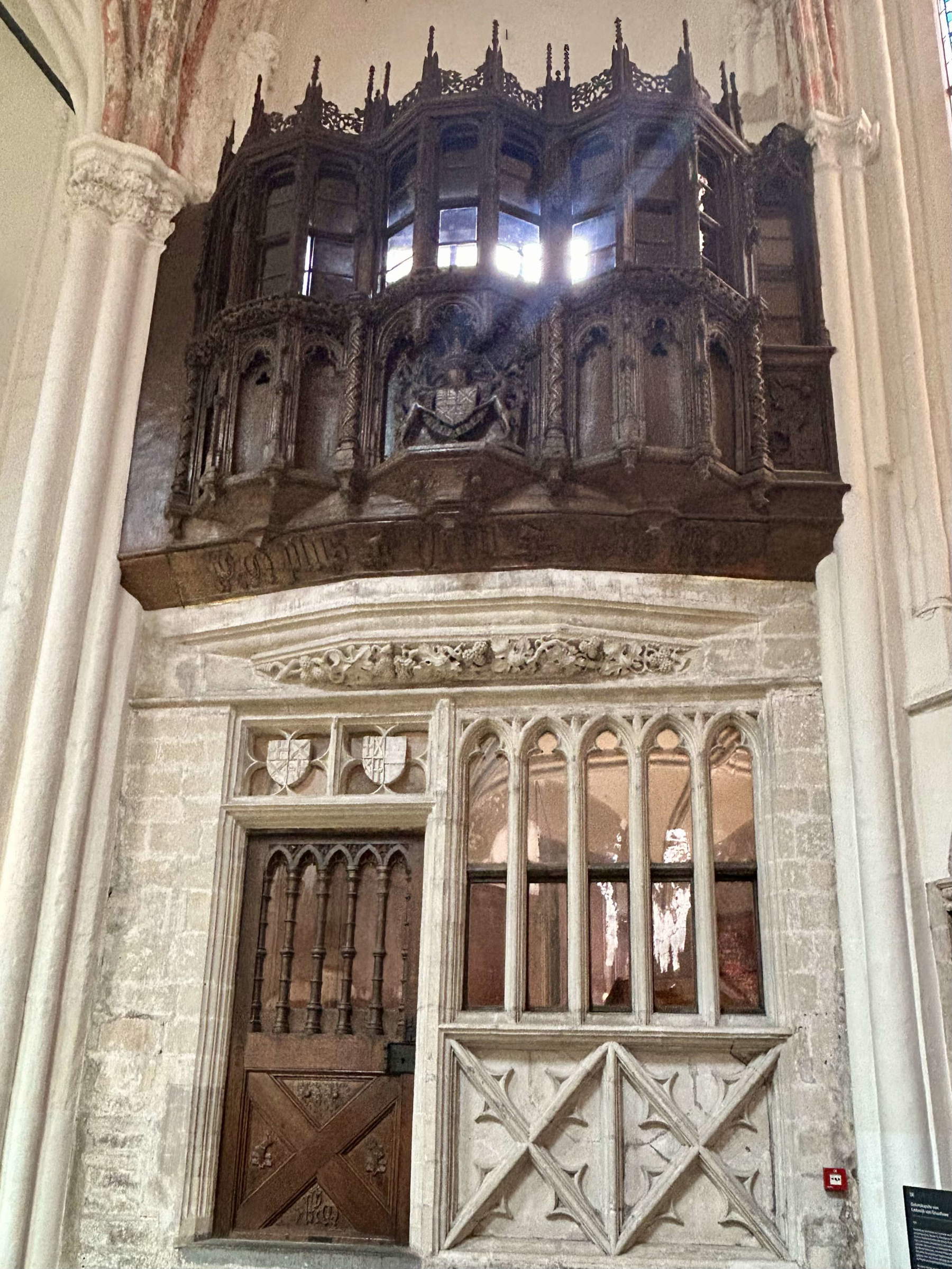
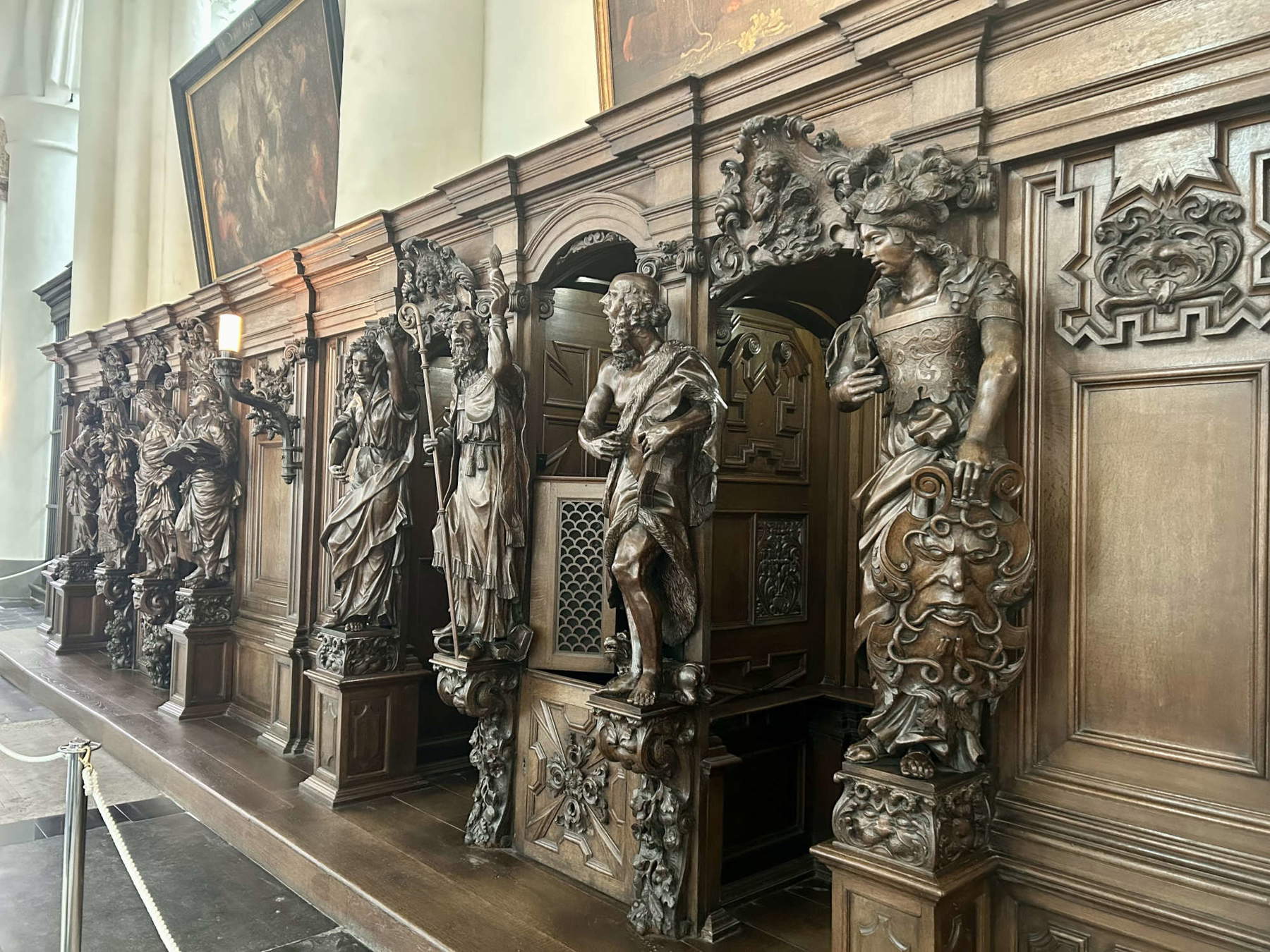
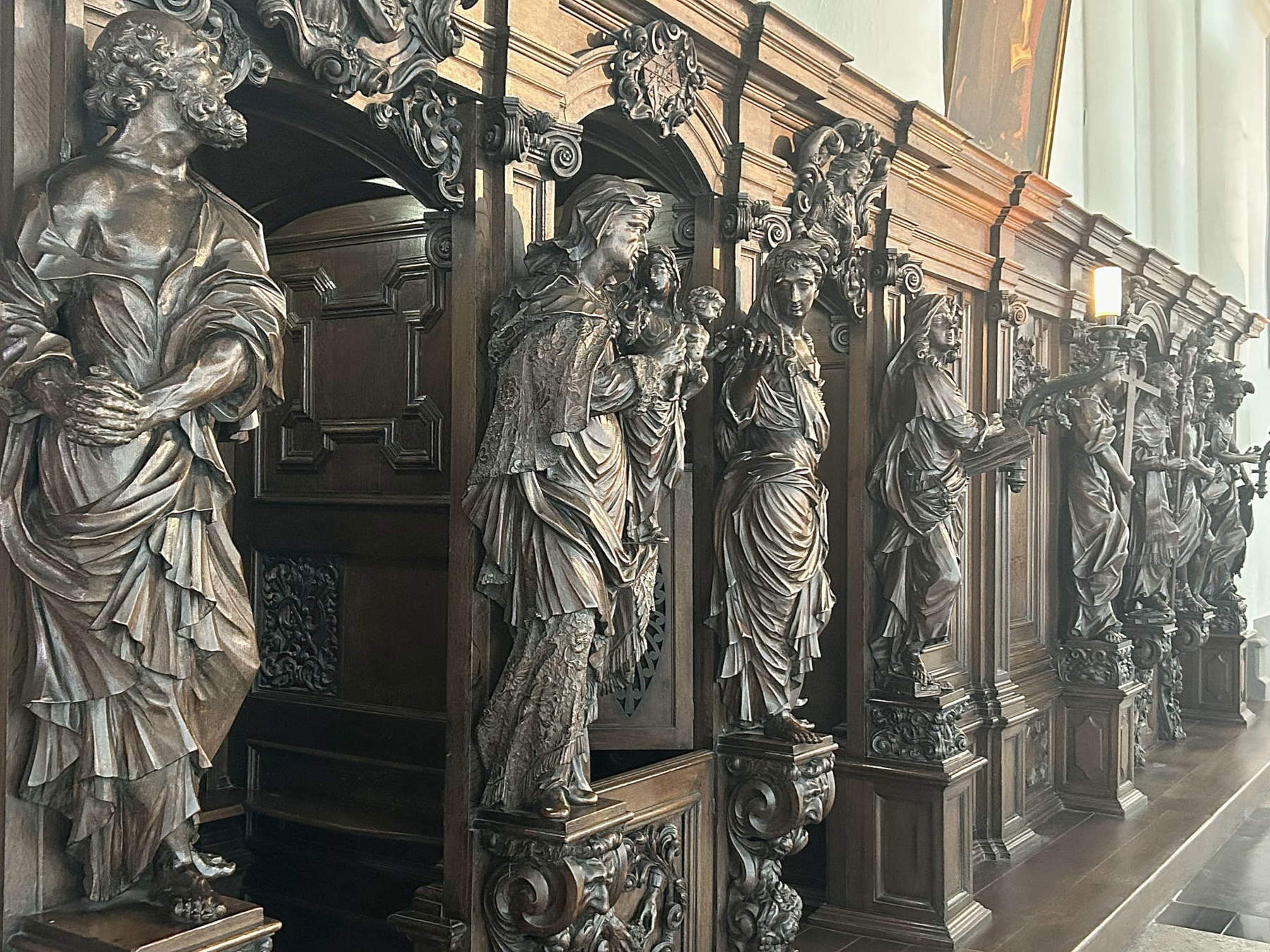
The counselor’s body rests behind the imposing Baroque tombstone that dominates the chapel between the two windows; also in this space are three tombs of medieval origin that testify to a custom prevalent in Bruges from about 1270, and which saw the interior of the tombs painted in brick. The brightly colored paintings show sacred figures, crosses and flowers. These depictions were executed with great haste, as in the Middle Ages the dead were often buried the same day they died, forcing painters to work in great haste and crouch in the tombs, where they executed their drawings on wet lime, but with rather coarse results.
Of great interest are several paintings and dossals scattered throughout the museum space, the most notable of which are anAdoration of the Shepherds painted by Pieter Pourbus in 1574, and commissioned by a jurist from Bruges who is depicted with his children in the left panel, while his wife and daughters are eternalized in the right panel. A red cross can be seen on the foreheads of some of them, as they were already deceased when the painter created the work.
Pourbus’ intervention is also found in the triptych with the Transfiguration of Christ, which was commissioned from Gerard David, a Dutch-born painter who trained in the style of Hans Memling. The work, which is dated to the early sixteenth century, shows a fresh and scenic layout in the central panel, while the two side panels painted by Pourbus some seventy years later reveal the artist’s difficulties in adapting to David’s style.
Also by Pourbus is a monumental Last Supper, while here is also the masterpiece of Adriaen Isenbrandt, who followed Gerard David’s lesson and whose work is also preserved in the church of San Pancrazio in Genoa. The panel with Our Lady of the Seven Sorrows shows a certain interest in the art of the Primitives but also a taste for classical elements to which the architecture of the main scene, around which the stories of the Seven Sorrows are developed, is delegated. Also discreet is a Supper at Emmaus by Hendrik Ter Brugghen, an artist who came into contact with Caravaggio’s style during his trip to Italy, and a Crucifixion by Antoon van Dyck.
But it is in the chancel that some of the church’s most extraordinary works are concentrated: suspended over the altar is the luxurious Triptych of the Passion painted by Barend van Orley and Marcus Gerards in 1534. The installation of the painting and the gates are part of an overall renovation of the sacral area, carried out in preparation for the movement of the remains of Charles the Bold, which were not received here until 1563, more than eighty years after the leader’s death. In fact, the very powerful duke of Burgundy, who had long nurtured expansionist and power-driven ambitions, even hoping to escape the yoke of being a vassal of the king of France and thus be able to see his possessions become a kingdom, died in 1477 while laying siege to Nancy in Lorraine. His body was not found until two days later, with his skull cracked open, and he long found rest in a church in the French city.
But before the duke, the church already housed the body of his ill-fated and only daughter, Mary of Burgundy, who in her lifetime saw the kingdoms she had inherited from her father drastically reduced and who perished pregnant by falling off a horse in 1482. At the behest of her husband Maximilian of Habsburg, later to become emperor of the Holy Roman Empire, the sumptuous tomb was commissioned. The wooden model was created by sculptor Jan Borreman with the help of Renier van Thienen, and later gold-plated and enameled by goldsmith Pierre de Beckere.
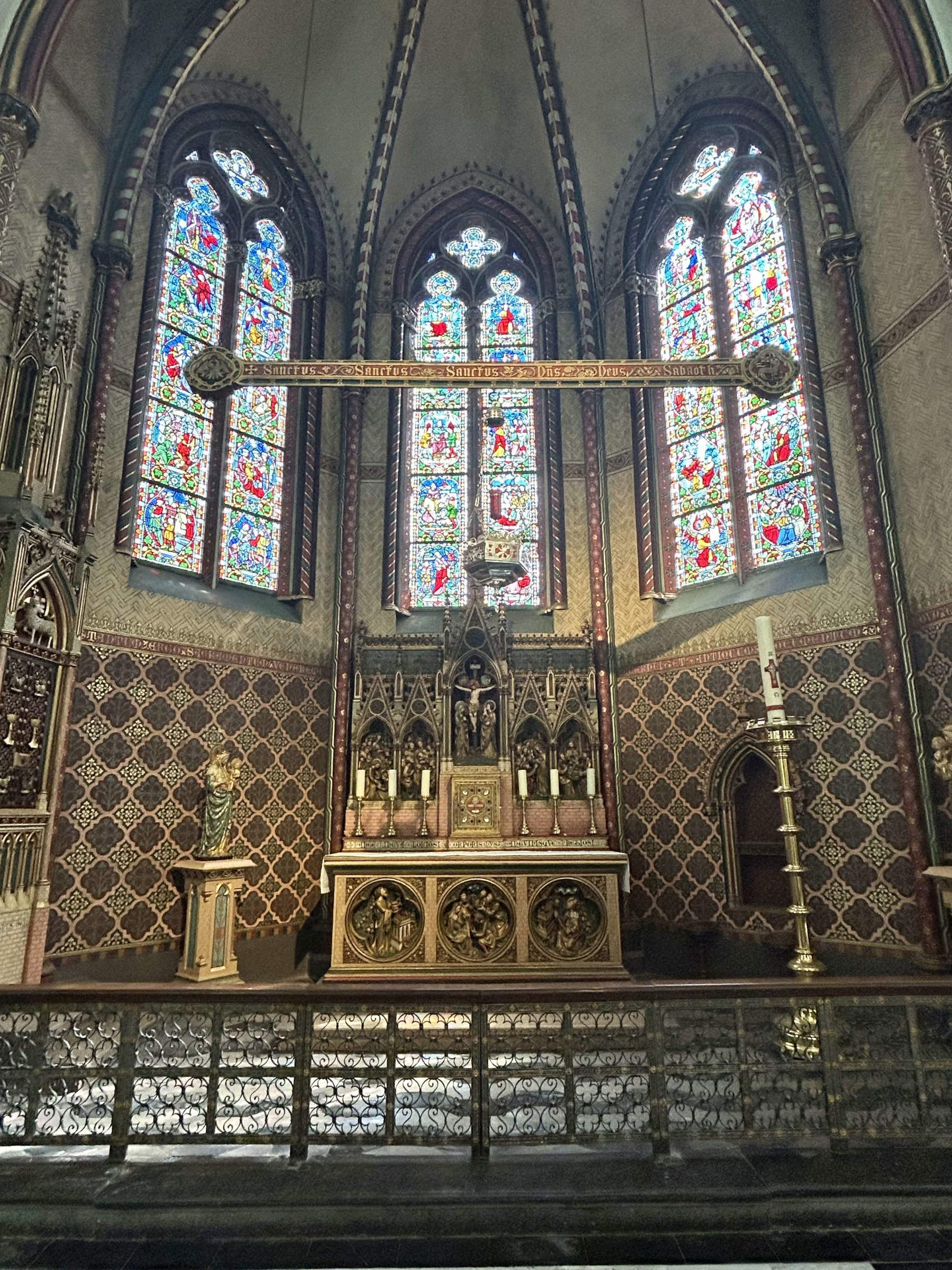


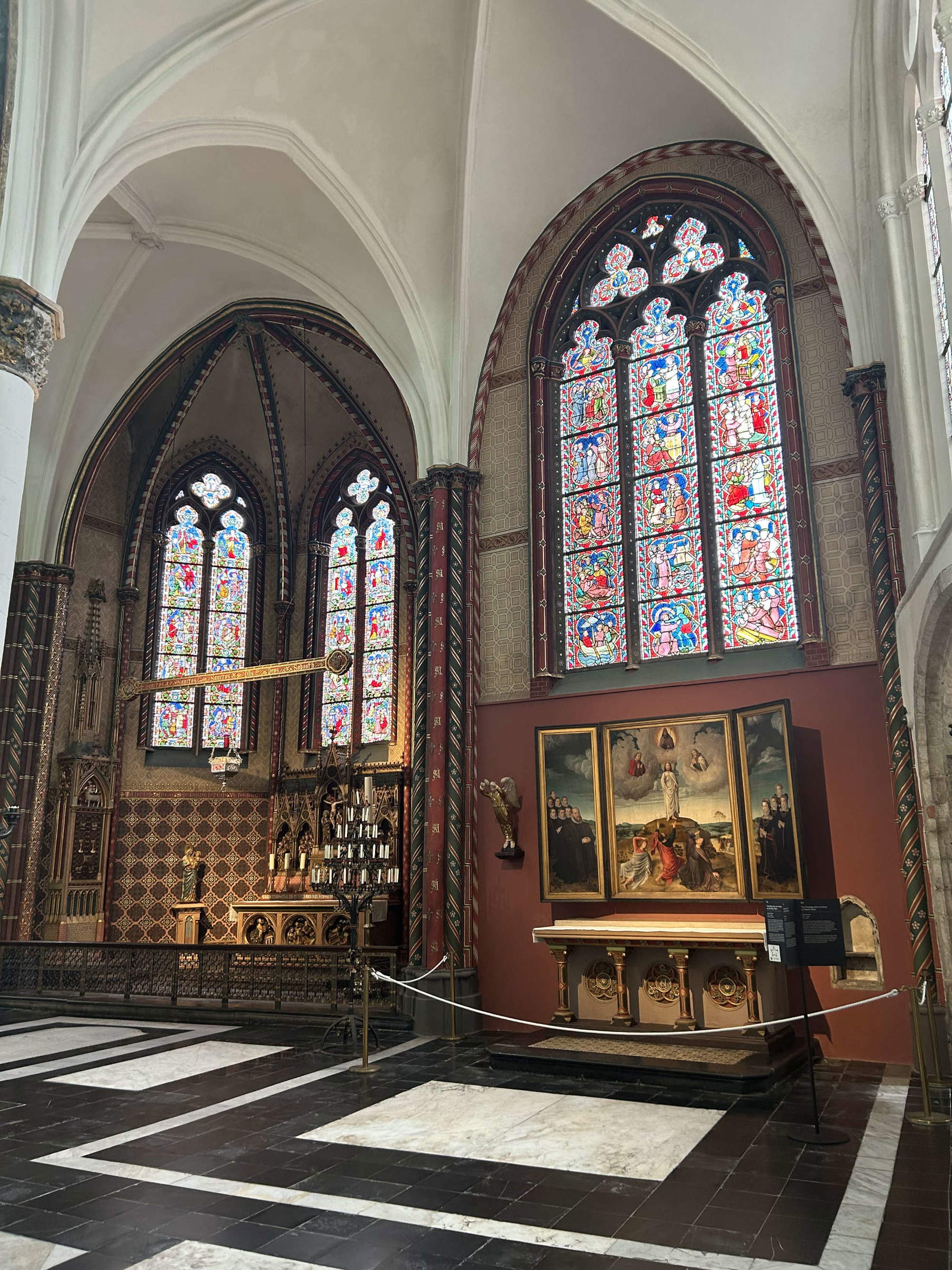


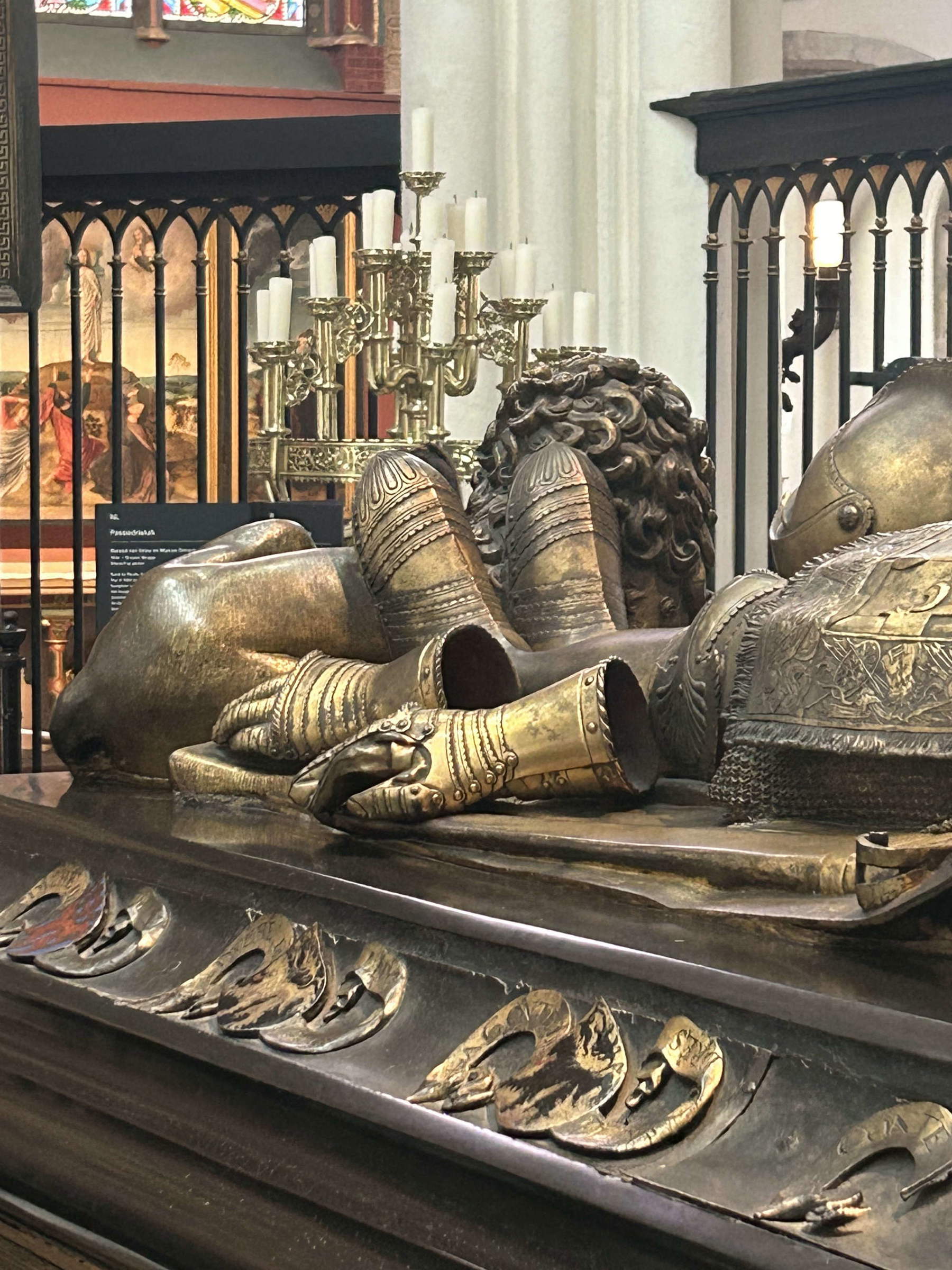
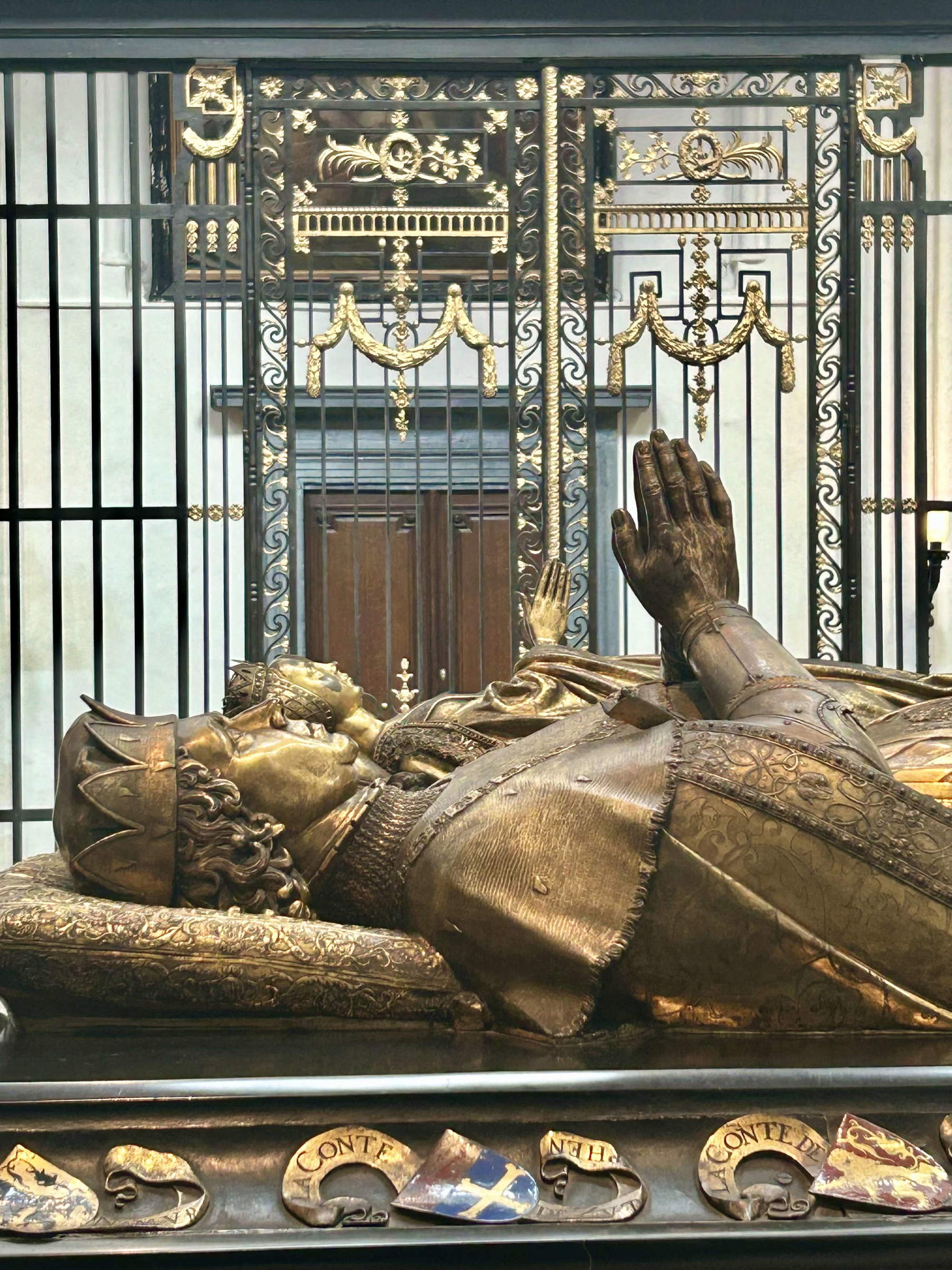

Made between 1490 and 1502, the late Gothic-style funerary monument, which depicts the supine noblewoman with her hands in prayer and adorned with a luxurious historiated robe and crown, is a masterpiece of fresh naturalism, especially in the rendering of facial expressions. The black marble sarcophagus below is adorned with the copper family trees of her mother and father, while at her feet stretches a dog symbolizing female fidelity.
To not dissimilar design also responds the tomb of Temeraire, which being later also shows elements that open more decisively to the Renaissance, such as the nymphs holding up the shield and in the style of the armor worn by the duke, who also flaunts the symbols of membership in the Order of the Golden Fleece, while at the feet is the lion, a symbol of strength. It is a work by Jacques Jonghelinck, who also studied in Italy at the workshop of sculptor Leone Leoni.
Still numerous treasures are housed in the church, but among all the golds, stained glass windows, mammoth sculptures and imposing altar dossals, it is just under 130 centimeters of marble that attracts the visitor’s attention, constituting the true and unsurpassed masterpiece of the church. So much measures the celebrated sculpture of the Madonna and Child, the eternal work of Michelangelo Buonarroti, that in spite of its restrained measurements it qualitatively giantizes in the context where it is inserted, a monumental altar of black marble and columns, built to a design by Jan de Heere of Ghent, created on behalf of the wealthy merchant family of Mouscron, the same ones who commissioned the statue from Michelangelo. The altar was built several decades after the arrival of Michelangelo’s work, probably from the plaque at the base of the altar, shortly before Pierre Mouscron’s death in 1571: Pierre Mouscron, like others of his family, was buried here.
The ’altar seems absolutely out of proportion to the small statue, beside which are two gigantic allegories, which, like the altar, manage to disappear in comparison with the masterpiece. The pale whiteness of the statue imprints itself on the black marble of the niche, enhancing its formal virtuosity. Michelangelo carved the statue from a single block and depicts a Madonna seated on a throne, from the Byzantine iconography Sedes sapientiae, from which it departs, since the child does not appear to be in her arms, but as if she were wriggling out of her mother’s grasp to move a few steps toward the viewer. It is on the mother-child dualism that the strength of the sculptural group is based, with the placid and motionless Madonna and the Child displaying great vital energy, so too the woman’s heavy drape, which resolves itself into abundant folds and covers every inch of skin, is opposed to the soft nudity of the Jesus, or Mary’s pensive and sad air that is contrasted instead with the impetuous confidence of the Redeemer.
The cloak gracefully drapes and frames Our Lady’s head, making her preoccupied and absorbed face stand out, whose eyes elude contact with the Child as much as with the audience, a prodromal sign symbolizing awareness of the inauspicious destiny to which her son is destined to redeem all humanity from sin. She may have read its events in the book of Scripture that she holds with one hand, while with the other she tries in vain to hold Jesus, to hold him to herself, to protect him from that glorious and bloody task.
All tenderness and intimacy between the two is mandated by the crossing of their hands. The emotional fragility and feminine grace is contrasted by the boldness of the child, tall and sturdy like a little Hercules: he is ready and has no hesitation about the task he must fulfill. His tender, polite body is ready to detach itself from the one that bore him. The whole group is veined with a classical temperament, perceptible in the anatomical rendering of the two, as much as in the rich folds of the Madonna’s robe, and in that Antinoo-like Mediterranean head of the child. The Madonna was carved in the round, with a translucent treatment of the marble, capable of retaining the secret of a luminous sheen that reverberates on the bodies, except for a few pieces, such as a shoulder and the rocks at her feet that still show signs of the chisel.



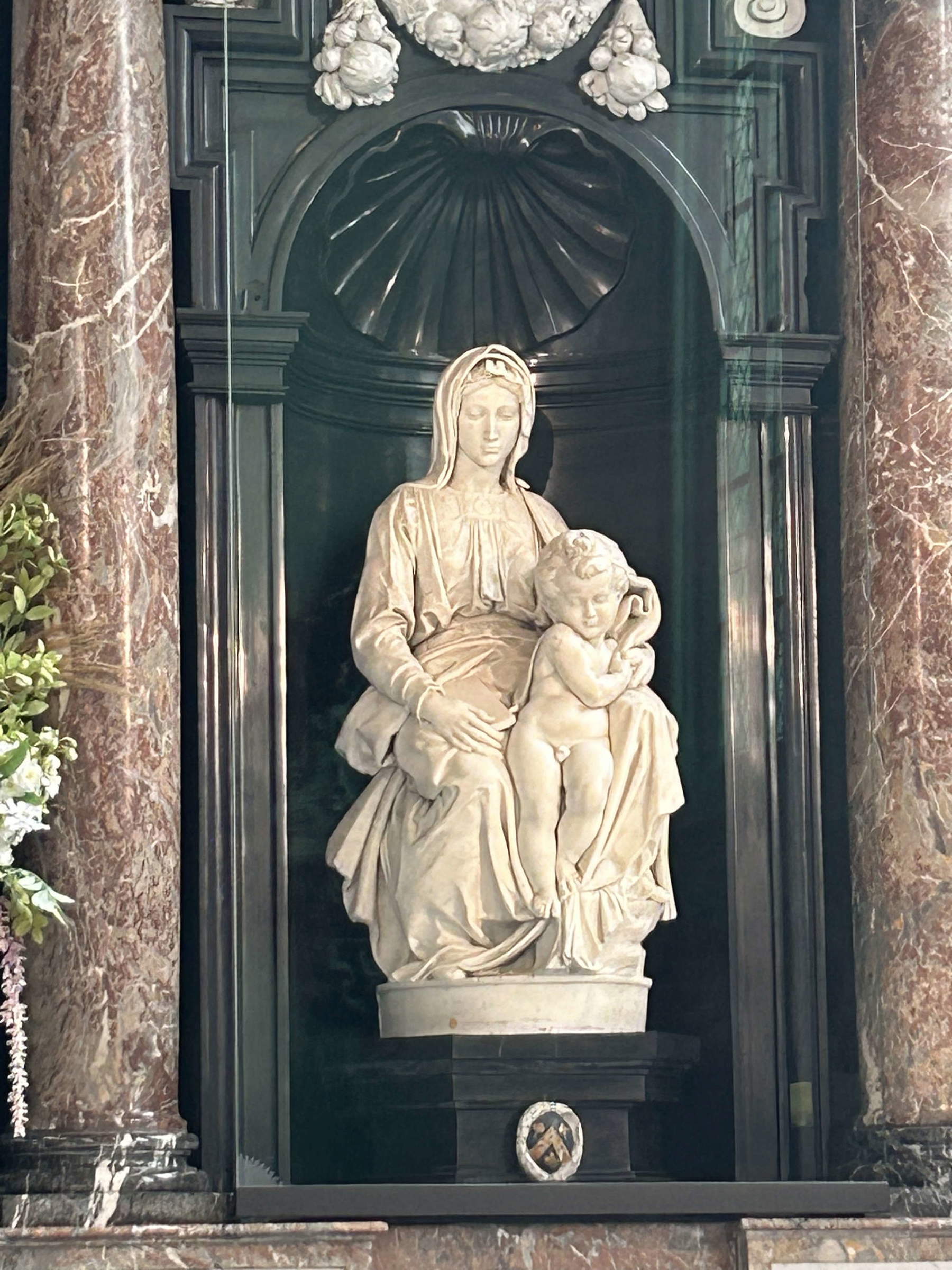
Despite the immense fame of the statuary group, the origins of the genesis of this masterpiece are still unclear, partly because it was the author himself who kept it confidential. Michelangelo was faced with the commission of the Madonna and Child when he was relatively young, but in those very years his career was undergoing a decisive turnaround, and his fame was spreading like wildfire. By 1499 he had distinguished himself with the creation of his first major masterpiece, the Pieta created for St. Peter’s Basilica in Rome, while two years later, upon his return to Florence, he obtained the commission for the David.
Rather unanimously, in fact, critics believe they trace the premises of the Bruges Madonna in the time span between the two works, or at any rate in the Florentine years consummated between 1501 and 1505. But it was Wilhelm Reinhold Valentiner who in 1942 proposed relating it to thePiccolomini Altar. Michelangelo, in fact, in 1501 accepted a commission from Cardinal Francesco Todeschini Piccolomini, the future Pope Pius III, to create fifteen statues for the Piccolomini Altar in Siena Cathedral. This project, interrupted and resumed five times, was never really completed by Michelangelo, who made only four saints, later deciding to abandon a commission that must have proved too limiting for the artistic prestige he was gradually acquiring.
According to Valentiner, Michelangelo decided to carve the Madonna, although not mentioned in the Sienese contract, for the central niche of the Piccolomini altar between 1504 and 1505, only to decide shortly afterwards to make a greater profit and sell it to the Mouscron brothers, wealthy cloth merchants who were natives of Bruges but also had interests in Italy (where they were also called “Moscheroni”). Even today the Valentiner hypothesis is hotly debated. What is certain is that the artist maintained the most absolute secrecy, so much so that his major biographers Vasari and Condivi speak of the Bruges Madonna in absolutely vague terms, with the former writing of it as a tondo while for the latter it was attested as a bronze.
The little known information comes from a few letters between Michelangelo and his father, in which he took care to ask “that marble Nostra Donna I would like you to have her brought there to the house and not let me see her in person,” and then later in which followed the transfer of the work to Flanders, which also took place in great secrecy from the port of Livorno or Viareggio. The reasons for the silence surrounding the work and its vicissitudes perhaps lie in the fact that the artist had not yet disengaged with the Piccolomini altar, whose patrons had been awaiting his services for some time.
Despite the caution exercised over the work, it has been noted how Raphael’s Madonna of the Goldfinch seems in some formal solutions to betray a direct knowledge of Michelangelo’s work. Undoubtedly, however, the Mouscrons shelled out a considerable sum for the work, that of 100 ducats, roughly equivalent to a year and a half’s salary of a good craftsman of the time. In 1514 the work was donated by Jan Mouscron and his wife to the church in Bruges, for which the new altar was made, on the condition that it would remain there forever. Unfortunately, this wish was disregarded, and the work was first stolen at Napoleon’s behest and taken to Paris, from where it returned with the fall of the French emperor, and then during World War II when it was requisitioned in September 1944 by German soldiers for Hitler’s vague museum. It was found the following year by the Monuments Men, the U.S. Army’s cultural heritage department, who spotted it in a salt mine in Altaussee, Austria. And the Bruges Madonna is now the highlight of a museum of extraordinary quality, albeit small in size.
Warning: the translation into English of the original Italian article was created using automatic tools. We undertake to review all articles, but we do not guarantee the total absence of inaccuracies in the translation due to the program. You can find the original by clicking on the ITA button. If you find any mistake,please contact us.




























